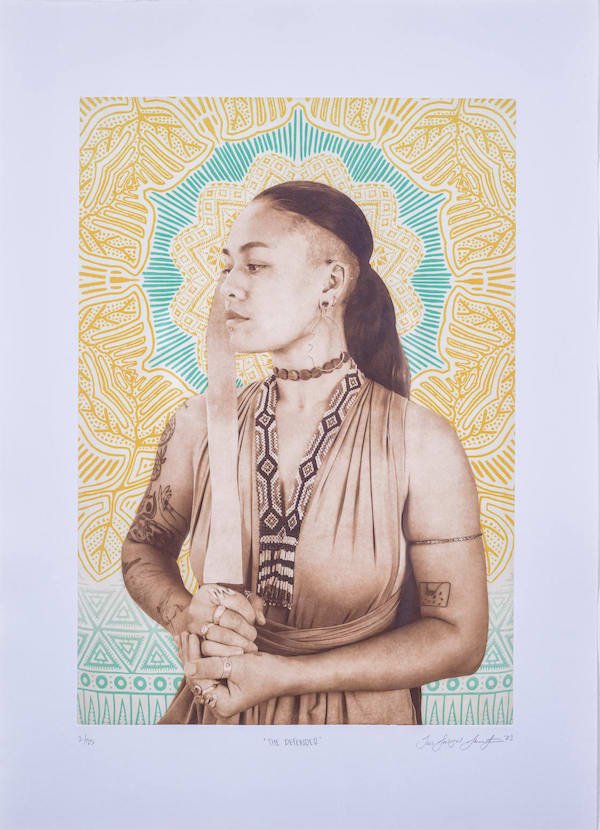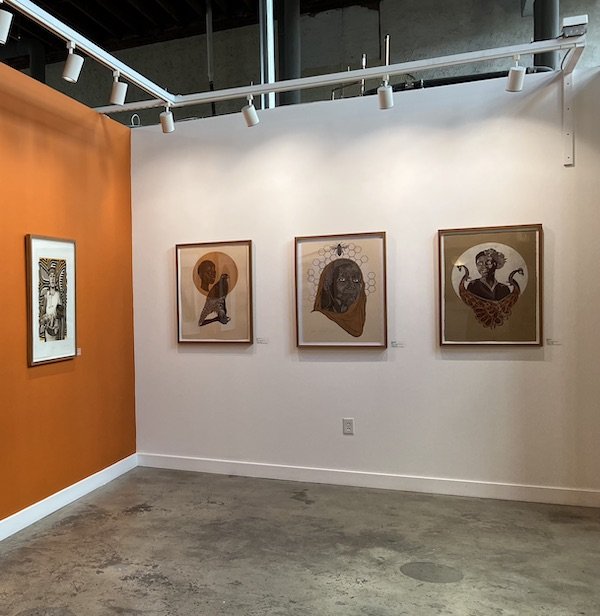Click here to read the original article >>
By Olivia Niuman on September 13, 2023
SANA(A), an exhibition of prints by artistic and life partners Jessica Sabogal and Shanna Strauss, debuts hand-printed works that display virtuosity of technique and dedication to potent themes of feminism, intersectionality, and collective care. Some works were made by Sabogal, some by Strauss, and some by both. While they each have distinct styles and nuanced themes, both artists center women in their practice, giving voice to Black, Indigenous, and women of color who have so often been ignored, sidelined, or intentionally oppressed. SANA(A) is on view at Pyramid Atlantic Art Center in Hyattsville, MD until September 24th.
The clever title of the exhibition captures how Colombian-American Sabogal and Tanzanian-American Strauss’s unique backgrounds come together in their shared artistic practice. Sana in Spanish is a command to heal, and Sanaa in Kiswahili defines the essence of art. These two themes—art and healing—are both expressed as processes that require attention, affection, and labor. Indeed, the highly physical printmaking processes employed by the artists can aptly be described as labors of love.

The Defender, a print created by Sabogal and Strauss during their Denbo Publishing residency, epitomizes the major themes that are present throughout the rest of the show. As the wall text explains, The Defender highlights the work of women to support and uplift their communities, which is often invisible and underappreciated. The subject is Filipina activist Malaya Tuyay, who holds a machete as symbol of the traditional Filipino martial artform Kali. The unaltered sepia colored portrait captured by their photopolymer gravure and photo lithography process presents the subject unapologetically as she is, while the chine-collé pattern in the background forms a halo around her head, elevating her to the level of a modern-day saint. The juxtaposition of the photographic image with decorative motifs is present in many of their jointly-made pieces. It is a striking way to introduce compositional drama in two dimensions by pushing the subject forward toward the viewer.

Healing of the Wound, another collaboration by Sabogal and Strauss, employs a similar technique to that of The Defender, with the subject presented in photographic grayscale and the background in brightly-colored chine-collé. The subject looks defiantly at the viewer, holding various objects that suggest traditional methods of healing with a stethoscope draped around her neck. Like the amalgamation of modern and traditional printing processes, the juxtaposition of traditional with modern medicine suggests that healing can be multifaceted and undertaken in a number of ways. As the work suggests, women are often relied upon to heal physical as well as emotional or psychological wounds, using whatever tools are at their disposal.

Jessica Sabogal most often works on a large scale, creating murals in San Francisco that disrupt the relatively male-dominated mural scene and public space in general. Her subjects are bright, loud, and unapologetic about taking up space. Her series, ¿A Dónde Llegaste, Chicanx?, features three women in bright primary colors (perhaps not coincidentally, also the colors of the Colombian flag) set in front of a composite of images of women and text. Subtle accents highlight the women in the background, drawing them forward and disrupting the traditional figure-ground relationship. It seems that here, even when literally using images of women as background, Sabogal is reluctant to relegate them to the shadows, instead giving them an active role. Rather than passive figures, the women in the background feel like ancestors—shadows that linger with continued importance.

A centerpiece of the show is Sabogal’s La Gran Maestra Yolanda López. López, a Chicana artist and activist, is framed by the years of her birth and death and an imperative to “make a ruckus.” The phrase Basta Ya! (Enough already!) takes up the upper right corner. It references the grassroots Spanish political movement by the same name that encouraged opposition to terrorism and violence through peaceful protests and demonstrations. In the gallery space, the print is foregrounded by an altar offering crayons, colored pencils, and prayer candles. The candles feature the Virgin of Guadalupe, whom Yolanda López often reinterpreted in her drawings, paintings, and prints. Also on the altar are tape and a pencil sharpener housed in pill bottles, suggesting again the healing potential of artistic practice. Altogether, Sabogal draws from a variety of political, social and artistic references, acknowledging her artistic heritage and encouraging her viewers to be more informed participants in social causes.

Compared to Sabogal’s brightly hued graphic prints, Strauss works with a range of earth tones and visible hands-on techniques. Instead of smooth graphic lines, Strauss’s prints leave the trace of their hand-carved linoleum blocks. The presence of the artist and her obvious labor is emphasized even further in pieces like The Visit and 2020, which both focus on hands, delicately cradling a bee or sewing up a heart, respectively. Pops of gold leaf, present in most of Strauss’s works, suggest a hidden power or overlooked value, like gold buried deep in the earth.
Shades of umber, terra cotta, and cream contrast nicely with paper that also varies in hue, lending a rich earthiness to pieces like Nia, Ajabu na Nyuki, and Guardians. Hung together as a set of three, each piece features a woman looking placidly at the viewer, head ringed with a halo, accompanied by an animal. Bees and birds suggest flight, freedom, and femininity. Even to a viewer who doesn’t know the subjects by name, they seem powerful, wise, and sacred.

Strauss’s Kanga series, a set of three apparently female figures, depicts women through their absence, as silhouettes adorned by luscious folds of cloth. The use of gallery space is well-executed here, as Kanga I, II, and III are hung directly across from Sabogal’s ¿A Dónde Llegaste, Chicanx? series. Like that group, the Kanga series is composed of figures in triplet and in primarily red, blue, and yellow. While Sabogal provides faces, words, and political references, Strauss’s take up notions of representation and invisibility by not technically depicting women at all. Strauss’s use of silhouettes beckons a reference to Kara Walker’s silhouettes, similarly drawing the viewer in through suggestion and leaving room for the mind to wander—who are these women? What are their stories? Just like with millions of Black and Indigenous women now and throughout history, these questions remain unanswered. But, the work of artists and activists like Sabogal and Strauss honors them through community and art.
SANA(A) is on view at Pyramid Atlantic Art Center until September 24th, 2023. Pyramid Atlantic Art Center is located at 4318 Gallatin Street Hyattsville, MD 20781. Gallery hours are Wednesday–Thursday 10am–8pm and Friday–Sunday 10am–6pm; the gallery is closed Monday-Tuesday. More information about the exhibition can be found here.